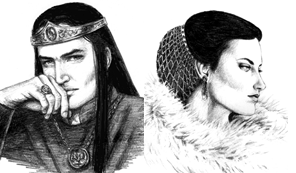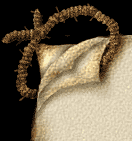|
"A Matter of
Fashion"
by Rayth, Lord Blackmoore and Nynis, Lady Goldkeeper
portraits by Brett
 Greetings,
gentle readers! Greetings,
gentle readers!
In the last edition of "A Matter of Fashion", Lord
Rayth discussed the fashions of the Crossing. Our third edition
will cover the styles of Leth Deriel and Ilithi.
As one moves south of the Segoltha from Crossing, one finds
that style takes a very different direction. One no longer
sees the Crossing style of waistcoats or top hats on gentlemen,
and certainly there are no corsets or wide petticoats on the
ladies of Leth Deriel or Shard. The fashionable set in these
lands are usually Elven or Elothean, and as one might expect,
they have dispensed with the structured clothing of the northern
cities. Instead, one sees looser and less restrictive garments,
exotic fabrics, and cleanly draped lines.
Leth Deriel is the home of thriving cloth and tanning industries,
both of which are evident in the high quality and great beauty
of the city's garments. The most important item for a fashionable
man of Leth Deriel is hose made from the incomparable Elven
silk -- a most commendable garment that sets off a man's physique
to perfection.
Rayth: Personally, I would recommend silk hose to any man
who wishes to dress fashionably. They suit styles from Riverhaven
and those south of the Crossing equally well, so their versatility
makes them a practical choice.
Nynis: And most gentlemen pair the hose with a hip-length
tunic or jerkin in damask or wool, although fine quilted doublets
are seen on distinguished men of the upper class. Leth Deriel's
doeskin and suede are also excellent choices for the man who
prefers more durable clothing.
Ladies of Leth Deriel wear silk and gossamer blouses, skirts,
and sarongs in a variety of colors and floral patterns. Leth
Deriel's dyes are famous throughout the world, especially
its soft greys, whites, and roses, as well as the deeper blues
and greens. A woman cannot go wrong with Leth Deriel colors
tastefully combined, but a cautionary word must be said about
conventions surrounding the infamous sarong. This garment
has a lovely effect when worn properly and with a bit of restraint.
The genteel lady of fashion will wear a light silk robe or
some other garment over her sarong when in public, to distinguish
her from women of lesser virtue.
Leth Deriel's jewelry is exquisite, with a wide range of
items worked in white gold, jade, and ivory, as well as lifesculpted
vines such as asmine, honeysuckle, and clematis. Coronets,
jeweled girdles, and torques of these materials are among
the city's greatest treasures.
R: Interestingly enough though, they do not work in silver.
It is hard to tell whether that is the personal preference
of the Leth Deriel Jewelers, or an Elven affectation in general.
N: I saw very little silver jewelry among the Elves of Ilithi
also. I assume it is characteristic of the race, but when
they are so skilled at working gold, who can complain?
Across the Obsidian Pass to the south, the fashions turn
even further from northern style. Ilithic fashion consists
of flowing layers of generously draped robes and tunics in
silk and gossamer. This illustrates a central truth of fashion
in Ilithi: the more fabric one wears, the higher one's status.
Oversleeves are billowing and fall nearly to the ground, often
with pleated seams to fit more yards of material into the
robe. The innermost garment is usually a floor-length silk
tunic, with layers of robes belted loosely around the waist
by a wide sash of fine material.
Few upper-class Ilithic men choose to wear the northern style
of pants; most wear floor-length robes or tunics in muted
colors. The noble ladies wear much more brilliant colors,
frequently layering shades of red with gold and yellow, or
blue with green and indigo, as their fancies suit them. In
general, the brighter the hue, the more fashionable the garment.
R: If I had to summarize fashion in Ilithi in one word, it
would be color. There are exceptions such as Guildmistress
Melear, who wears grey, but even she makes grey the entire
point of her wardrobe, not a side-note.
N: Yes, I think it's fair to say that subtleties are lost
in Ilithi, especially subtleties in color. This point is illustrated
by the fact that the shimmering and iridescent fabrics are
the most stylish of all. The techniques used to produce these
fabrics are a closely guarded secret, being an important part
of the Ilithic economy. Patterns and embroidery are also in
the height of fashion, with intricate needlework being done
in gold thread and ornamented with numerous small jewels and
seed pearls.

Jewelry is extravagant, with great preference given to the
famous Ilithic emeralds as well as rubies, sapphires, opals,
and the more unusual stones provided by the mines of the Dragon's
Spine mountain range. Ladies arrange their hair intricately
and adorn it with jeweled hairpins, coronets, or circlets,
while gentlemen wear rings, amulets, and circlets. Some ladies
cover their hair or face with translucent veils falling to
the waist or to the floor, and shoes worn by both ladies and
gentlemen are brocaded and jeweled with long, pointed toes.
Boots are nearly unknown among the genteel class south of
the Obsidian Pass.
R: To those wearing the most fashionably delicate of these
shoes, I recommend either not going outside, or more practically,
obtaining a pair of pattens. These are wooden clogs that fit
over your nice shoes and keep them as new, and out of the
mud.
N: By the way, some ladies wear a tall, ornamented variety
of pattens called chopines, which add several inches to their
height and keep their skirts out of the mud.
The scholars, mages, and less fashionable classes of Ilithi
dress more simply in unornamented silk robes and tunics in
greys, deep blues, and black. Some men wear cowls or hoods,
and boots and leggings are seen among the working class. However,
Ilithi in general is a province where extravagance has overtaken
utility, which results in some of the most stunning and unique
fashions known anywhere in the realms.
R: Our next month's article will travel all the way north,
to the Province of Therengia. Depending on our luck, we may
have another interview as well.
Until then, Good Reader, farewell - and dress magnificently.

|










 Greetings,
gentle readers!
Greetings,
gentle readers!
